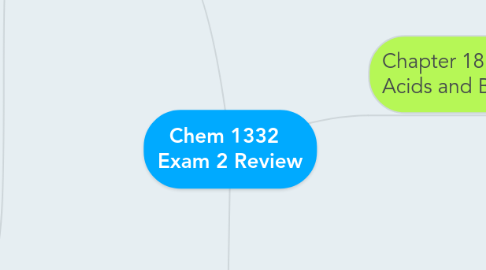
1. Chapter 16: Kinetics
1.1. Reaction coordinate diagram
1.1.1. Break bond: endothermic (+), needs E
1.1.2. Make bond: exothermic (-), gives off E
1.1.3. E(a), activation energy: always positive
1.2. Arrhenius Equation
1.2.1. k = Ae^(-Ea/RT), R = 8.314 J/mol.K
1.2.2. ln(k) = ln(A) - (Ea/RT)
1.2.3. Incr. temp -> more collisions & energy -> rxn speeds up
1.3. Mechanism
1.3.1. Rate of reaction depends on the SLOWEST STEP of the mechanism -> rate law
1.3.1.1. rate = k[A]^n * [B]^m
1.3.2. Steps must add to overall reaction & be balanced
1.3.3. Each step must be unimolecular/bimolecular
1.3.4. Intermediate steps cancel each other out
1.3.5. Catalyst speeds up a reaction & lowers Ea
2. Chapter 17: Equilibrium
2.1. Equilibrium
2.1.1. All reactions are reversible
2.1.2. concentrations of all species become constant
2.1.3. Exothermic: right side more stable
2.2. Keq expressions
2.2.1. forward rate = reverse rate
2.2.1.1. forward rxn rate law = reverse rxn rate law
2.2.1.2. k(f)/k(r) = [products]eq^n / [reactants]eq^m
2.2.1.3. k(f)/k(r) = Keq
2.2.1.4. Keq = [products]eq^n / [reactants]eq^m
2.2.1.4.1. Keq > 1: more products than reactants at equilibrium
2.2.1.4.2. Keq: mol/L -> Kc
2.2.1.4.3. Flip eqn: K -> 1/K
2.2.1.4.4. Multiply eqn by n: K -> K^n
2.2.2. Concentration of solids & liquids = constant & given temperature (mol/L = density/MM)
2.2.2.1. Omit (s) & (l) from K expression; only include (g) and (aq)
2.2.3. Use partial pressure of gases -> Kp
2.2.3.1. pV = nRT
2.2.3.2. Kp = Kc(RT)^Δ n
2.2.3.3. delta n = change in # moles of gas
2.2.4. Qc = [products]^n / [reactants]^m (not at equilibrium)
2.2.4.1. Q<K: rxn go --->
2.2.4.2. Q>K: rxn go <---
2.2.4.3. Q=K: rxn at equilibrium
2.2.5. Multi-step equilibrium calculations: A + B <=> C + D, Kc A + B <=> W, Kc1 W <=> C + D, Kc2 Kc1 * Kc2 = Kc
2.3. Le Chatelier's Principle
2.3.1. Reaction at equilibrium: Q = K
2.3.2. If a change is made, the reaction will move in the direction opposite to the change
2.3.3. Add reactant: rxn --> make products, use reactants
2.3.4. Remove reactant: rxn <--- make reactants, use products
2.3.5. Add heat: changes K, rxn goes in ENDOTHERMIC direction
2.3.6. Decr. pressure or incr. volume: only for gases, goes in direction of more gas moles
3. Chapter 18: Acids and Bases
3.1. Arrhenius Acids
3.1.1. Strong Acids: Totally dissociate into H+ and anion; Ka is v. big
3.1.1.1. HCl(aq)
3.1.1.2. HBr(aq)
3.1.1.3. HI(aq)
3.1.1.4. HNO3(aq)
3.1.1.5. HClO4(aq)
3.1.1.6. H2SO4(aq)
3.1.2. Weak Acids: Partially dissociate (SCE chart); Ka is small
3.2. Arrhenius Bases
3.2.1. Dissociates in H2O --> OH-
3.2.2. Strong Bases: Kb is v. big
3.2.2.1. LiOH(aq)
3.2.2.2. NaOH(aq)
3.2.2.3. KOH(aq)
3.2.2.4. RbOH(aq)
3.2.2.5. CsOH(aq)
3.2.2.6. Ba(OH)2(aq)
3.2.2.7. Sr(OH)2(aq)
3.2.3. Weak Bases: Partially dissociate (SCE chart); Kb is small
3.3. Arrhenius Neutralization:
3.3.1. acid + base -> H20 + "salt"
3.3.2. H+anion + cationOH- -> H2O + cationanion
3.4. Bronsted + Lowry
3.4.1. Acid: HA + H2O <=> H3O+ + A- acid base acid base
3.4.1.1. Acid: proton donor (H+)
3.4.1.2. In general: HA + B <=> A + HB
3.4.1.2.1. Equilibrium depends on relative strength of HA and HB
3.4.1.2.2. Conjugate pair: stronger the acid, the weaker its conjugate base
3.4.1.3. Ka(HA) in H2O = [H3O+]eq [A-]eq / [HA]eq
3.4.1.4. pH = -log[H3O+]eq
3.4.2. Base: B + H20 <=> BH+ + OH- base acid acid base
3.4.2.1. Base: proton acceptor (H+)
3.4.2.2. pOH = -log[OH-]eq
3.4.3. Water is amphiprotic
3.4.3.1. Auto-dissociation of H2O: H2O(l) + H2O(l) <=> H3O+(aq) + OH-(aq)
3.4.3.2. Kw = [H3O+]eq[OH-]eq = 10^-14
3.4.3.3. pH + pOH = 14 at 25 degrees C
3.4.3.4. In pure water/neutral solution: [H3O+]eq = [OH-]eq = 10^-7
3.5. Types of Acids
3.5.1. Binary Acids (HnX)
3.5.1.1. X nonmetal
3.5.1.2. X on periodic table; Acid strength incr w/: --------------> (EN priority) l V (size of X)
3.5.2. Oxy Acids (HnXOm)
3.5.2.1. nonmetal hydroxides
3.5.2.2. No size effect on strength
3.5.2.3. Secondary EN effect: acid strength incr (towards top right corner)
3.5.2.4. More O atoms, stronger the acid
3.5.3. Organic (carboxylic) acids (-COOH)
3.5.3.1. More EN atoms --> incr. acid strength
3.5.4. Cations
3.5.4.1. H-containing cation (NH4+)
3.5.4.2. Metal cation (M+) in aq. solutions
3.5.5. Polyprotic acids (HnA)
3.5.5.1. [H3O+] & pH only come from the first reaction
3.5.5.2. [H2anion-] only comes from first reaction (1st conj. base)
3.5.5.3. [Hanion2- ]eq = Ka2
3.5.5.4. Ka1 >> Ka2 >> Ka3
3.6. Types of Bases
3.6.1. Metal hydrides
3.6.1.1. NaH, KH, etc.
3.6.2. Metal hydroxides
3.6.2.1. NaOH(aq)
3.6.3. Organic bases (amines)
3.6.3.1. NH3 (ammonia), CH3NH2 (methylamine), etc.
3.6.4. Anions (A-)
3.6.4.1. A- + H2O <=> HA + OH-(aq) base acid
3.6.4.2. Strong Bases:
3.6.4.2.1. H- hydride (H2 conj. acid)
3.6.4.2.2. NH2- amide (NH3 conj. acid)
3.6.4.2.3. CH3O- alkoxides (CH3OH conj. acid; alcohol)
3.6.4.2.4. CH3- hydrocarbon anions (CH4 alkane conj. acid)
3.6.4.3. Weak Bases: (v.v.v.v. weak)
3.6.4.3.1. Cl-
3.6.4.3.2. Br-
3.6.4.3.3. I-
3.6.4.3.4. NO3 -
3.6.4.3.5. ClO4 -
3.6.4.4. Ka(HA) = Kw / Kb(A-)
3.6.4.4.1. Kw = 1E-14 at 298 K

